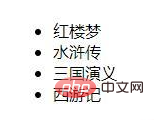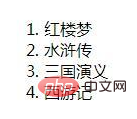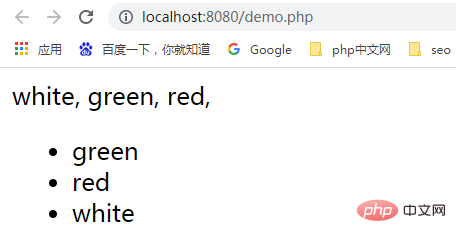 Backend Development
Backend Development
 PHP Tutorial
PHP Tutorial
 Teach you how to display the values in a PHP array using an unordered list
Teach you how to display the values in a PHP array using an unordered list
Teach you how to display the values in a PHP array using an unordered list
Hello everyone, today I will teach you how to play with tags and PHP arrays. As the title states, the theme of this article is to introduce how to use an unordered list to display the values in a PHP array. It is simple and easy to understand. Walk through it Don’t miss it when passing by~
First of all, let me explain to you what is an unordered list?
The so-called unordered list is a collection of list items in no specific order, also called an item list. Users can specify the style of bullets that appear in front of list items, including disc solid dots, circle hollow dots, square solid squares, and none bullets, which means that the list items are prefixed with solid circles, hollow circles, or solid squares.
For example:

Here is a brief introduction to the ordered list. An ordered list is an ordered list, that is, there is 123 or abc in front of the list, etc. Sequential prefix. (This article mainly introduces the unordered list method)
For example:

Then after understanding the unordered list, let’s create a PHP sample file;
Then upload the code directly. You can also copy the code directly and test it locally:
<?php
$color = array('white', 'green', 'red');
foreach ($color as $c)
{
echo "$c, ";
}
sort($color);
echo "<ul>";
foreach ($color as $y)
{
echo "<li>$y</li>";
}
echo "</ul>";Running results:

As shown in the figure , display array values in an unordered list~~
In the above code, we used the sort function, <ul><li></ul> tag, and foreachLoop traversal.
sort() The function sorts the index array in ascending order. This function assigns new key names to the units in the array, and the original key names will be deleted; of course, it can also Use the rsort() function to sort the index array in descending order.
<ul> </ul> Tag defines an unordered list. <li> </li>Tag defines list items. This tab page can be used in ordered list
- , unordered list
- and menu list
The above is the detailed content of Teach you how to display the values in a PHP array using an unordered list. For more information, please follow other related articles on the PHP Chinese website!

Hot AI Tools

Undresser.AI Undress
AI-powered app for creating realistic nude photos

AI Clothes Remover
Online AI tool for removing clothes from photos.

Undress AI Tool
Undress images for free

Clothoff.io
AI clothes remover

AI Hentai Generator
Generate AI Hentai for free.

Hot Article

Hot Tools

Notepad++7.3.1
Easy-to-use and free code editor

SublimeText3 Chinese version
Chinese version, very easy to use

Zend Studio 13.0.1
Powerful PHP integrated development environment

Dreamweaver CS6
Visual web development tools

SublimeText3 Mac version
God-level code editing software (SublimeText3)

Hot Topics
 1378
1378
 52
52
 How to use PHP arrays to generate and display charts and statistical graphs
Jul 15, 2023 pm 12:24 PM
How to use PHP arrays to generate and display charts and statistical graphs
Jul 15, 2023 pm 12:24 PM
How to use PHP arrays to generate and display charts and statistical graphs. PHP is a widely used server-side scripting language with powerful data processing and graphic generation capabilities. In web development, we often need to display charts and statistical graphs of data. Through PHP arrays, we can easily implement these functions. This article will introduce how to use PHP arrays to generate and display charts and statistical graphs, and provide relevant code examples. Introducing the necessary library files and style sheets Before starting, we need to introduce some necessary library files into the PHP file
 How to use PHP arrays to generate dynamic slideshows and image displays
Jul 15, 2023 pm 01:17 PM
How to use PHP arrays to generate dynamic slideshows and image displays
Jul 15, 2023 pm 01:17 PM
How to use PHP arrays to generate dynamic slideshows and picture displays. Slideshows and picture displays are common functions in web design and are often used in scenarios such as carousels and gallery displays. As a popular server-side scripting language, PHP has the ability to process data and generate dynamic HTML pages, and is very suitable for generating dynamic slideshows and picture displays. This article will introduce how to use PHP arrays to generate dynamic slideshows and picture displays, and give corresponding code examples. Prepare image data First, we need to prepare a set of image path data
 What are the functions for averaging arrays in php?
Jul 17, 2023 pm 04:03 PM
What are the functions for averaging arrays in php?
Jul 17, 2023 pm 04:03 PM
PHP array averaging functions include: 1. array_sum(), which is used to calculate the sum of all values in the array. In order to calculate the average, you can add all the values in the array and then divide by the number of array elements; 2 , array_reduce(), used to iterate the array and calculate each value with an initial value; 3. array_mean(), used to return the average of the array, first calculate the sum of the array, and calculate the number of array elements, then The sum is divided by the number of array elements to get the average.
 How to use PHP arrays to implement user login and permission management functions
Jul 15, 2023 pm 08:55 PM
How to use PHP arrays to implement user login and permission management functions
Jul 15, 2023 pm 08:55 PM
How to use PHP arrays to implement user login and permission management functions When developing a website, user login and permission management are one of the very important functions. User login allows us to authenticate users and protect the security of the website. Permission management can control users' operating permissions on the website to ensure that users can only access the functions for which they are authorized. In this article, we will introduce how to use PHP arrays to implement user login and permission management functions. We'll use a simple example to demonstrate this process. First we need to create
 What are php array key-value pairs?
Aug 03, 2023 pm 02:20 PM
What are php array key-value pairs?
Aug 03, 2023 pm 02:20 PM
PHP array key-value pair is a data structure consisting of a key and a corresponding value. The key is the identifier of the array element, and the value is the data associated with the key. It allows us to store and access data using keys as identifiers. By using key-value pairs, we can more easily operate and manage elements in the array, making program development more flexible and efficient.
 An exploration of performance optimization techniques for PHP arrays
Mar 13, 2024 pm 03:03 PM
An exploration of performance optimization techniques for PHP arrays
Mar 13, 2024 pm 03:03 PM
PHP array is a very common data structure that is often used during the development process. However, as the amount of data increases, array performance can become an issue. This article will explore some performance optimization techniques for PHP arrays and provide specific code examples. 1. Use appropriate data structures In PHP, in addition to ordinary arrays, there are some other data structures, such as SplFixedArray, SplDoublyLinkedList, etc., which may perform better than ordinary arrays in certain situations.
 How to convert a two-dimensional php array into a one-dimensional array
Aug 03, 2023 am 11:14 AM
How to convert a two-dimensional php array into a one-dimensional array
Aug 03, 2023 am 11:14 AM
How to convert a php array from two dimensions to a one-dimensional array: 1. Use loop traversal to traverse the two-dimensional array and add each element to the one-dimensional array; 2. Use the "array_merge" function to merge multiple arrays into An array. Pass the two-dimensional array as a parameter to the "array_merge" function to convert it into a one-dimensional array; 3. Using the "array_reduce" function, you can process all the values in the array through a callback function and finally return a result.
 How to determine how many arrays there are in php
Aug 04, 2023 pm 05:40 PM
How to determine how many arrays there are in php
Aug 04, 2023 pm 05:40 PM
There are several ways to determine an array in PHP: 1. Use the count() function, which is suitable for all types of arrays. However, it should be noted that if the parameter passed in is not an array, the count() function will return 0; 2. Use the sizeof() function, which is more used to maintain compatibility with other programming languages; 3. Custom functions, By using a loop to traverse the array, each time it is traversed, the counter is incremented by 1, and finally the length of the array is obtained. Custom functions can be modified and expanded according to actual needs, making them more flexible.



